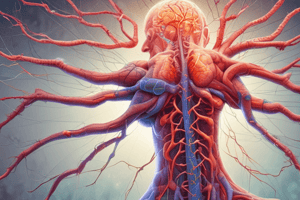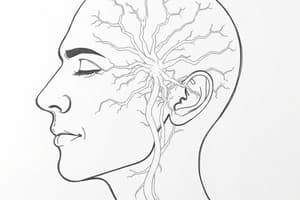Podcast
Questions and Answers
A patient reports pain along the path of the sciatic nerve without any observable structural damage. Which term best describes this condition?
A patient reports pain along the path of the sciatic nerve without any observable structural damage. Which term best describes this condition?
- Neuritis
- Neuralgia (correct)
- Neuroma
- Neuropathy
An MRI reveals inflammation of the L5 spinal nerve root. Which term accurately describes this condition?
An MRI reveals inflammation of the L5 spinal nerve root. Which term accurately describes this condition?
- Radiculitis (correct)
- Radiculopathy
- Plexopathy
- Polyradiculopathy
A patient presents with weakness and numbness in the arm, and imaging shows compression of the brachial plexus. Which term is most appropriate to describe this condition?
A patient presents with weakness and numbness in the arm, and imaging shows compression of the brachial plexus. Which term is most appropriate to describe this condition?
- Polyradiculopathy
- Radiculopathy
- Plexopathy (correct)
- Neuropathy
Which of the following best describes 'Double Crush Syndrome'?
Which of the following best describes 'Double Crush Syndrome'?
A physical examination reveals spontaneous contractions of muscle fibers in a patient's lower leg. What is the correct terminology for this observation?
A physical examination reveals spontaneous contractions of muscle fibers in a patient's lower leg. What is the correct terminology for this observation?
A patient who had a stroke now has paralysis in their left arm. The muscles are soft and offer no resistance to movement. Deep tendon reflexes are absent. Which term best describes this condition?
A patient who had a stroke now has paralysis in their left arm. The muscles are soft and offer no resistance to movement. Deep tendon reflexes are absent. Which term best describes this condition?
Following a nerve injury, a patient experiences a decrease in the size of their calf muscle. What is the correct term for this observation?
Following a nerve injury, a patient experiences a decrease in the size of their calf muscle. What is the correct term for this observation?
A patient presents with numbness, tingling, and weakness in both legs due to compression of multiple nerve roots in the lumbar spine. Which term is most appropriate?
A patient presents with numbness, tingling, and weakness in both legs due to compression of multiple nerve roots in the lumbar spine. Which term is most appropriate?
A patient reports experiencing sharp, shooting pains down their arm, but neurological examination and imaging studies reveal no structural abnormalities in the nerves themselves. Which of the following terms best describes this condition?
A patient reports experiencing sharp, shooting pains down their arm, but neurological examination and imaging studies reveal no structural abnormalities in the nerves themselves. Which of the following terms best describes this condition?
An MRI reveals inflammation of the nerve supplying the quadriceps muscle group. Which term accurately describes this condition?
An MRI reveals inflammation of the nerve supplying the quadriceps muscle group. Which term accurately describes this condition?
Electromyography (EMG) testing of a patient's calf muscle reveals spontaneous, involuntary contractions of individual muscle fibers. What term accurately describes this clinical finding?
Electromyography (EMG) testing of a patient's calf muscle reveals spontaneous, involuntary contractions of individual muscle fibers. What term accurately describes this clinical finding?
A patient presents with paralysis characterized by a complete lack of muscle tone and absent deep tendon reflexes in the affected limb. Which term best describes this condition?
A patient presents with paralysis characterized by a complete lack of muscle tone and absent deep tendon reflexes in the affected limb. Which term best describes this condition?
Following a prolonged period of immobilization due to a nerve injury, a patient's thigh muscle exhibits a noticeable reduction in size. What term accurately describes this observation?
Following a prolonged period of immobilization due to a nerve injury, a patient's thigh muscle exhibits a noticeable reduction in size. What term accurately describes this observation?
A patient is diagnosed with compression of the brachial plexus due to thoracic outlet syndrome. Which term accurately describes this condition?
A patient is diagnosed with compression of the brachial plexus due to thoracic outlet syndrome. Which term accurately describes this condition?
A patient experiences both carpal tunnel syndrome and compression of the median nerve as it passes between the two heads of pronator teres. Which of the following terms describes this scenario?
A patient experiences both carpal tunnel syndrome and compression of the median nerve as it passes between the two heads of pronator teres. Which of the following terms describes this scenario?
A patient presents with numbness, tingling, and weakness that affects multiple nerve roots in the cervical spine region. Which term is the most appropriate to describe this condition?
A patient presents with numbness, tingling, and weakness that affects multiple nerve roots in the cervical spine region. Which term is the most appropriate to describe this condition?
Flashcards
Neuropathy
Neuropathy
Functional disturbance/pathological change in nerve function.
Neuralgia
Neuralgia
Nerve pain without objective signs/structural damage.
Neuritis
Neuritis
Inflammation of a nerve.
Neuroma
Neuroma
Signup and view all the flashcards
Radiculitis
Radiculitis
Signup and view all the flashcards
Radiculopathy
Radiculopathy
Signup and view all the flashcards
Fasciculation
Fasciculation
Signup and view all the flashcards
Double Crush Syndrome
Double Crush Syndrome
Signup and view all the flashcards
Polyradiculopathy
Polyradiculopathy
Signup and view all the flashcards
Plexopathy
Plexopathy
Signup and view all the flashcards
Flaccidity
Flaccidity
Signup and view all the flashcards
Atrophy
Atrophy
Signup and view all the flashcards
Study Notes
- Neuropathy is a functional disturbance and/or pathological change in nerve function.
- Neuralgia is pain in the distribution of nerves, generally in the absence of objective signs or structural damage to the nerve.
- Neuritis is inflammation of the nerve.
- Neuroma is an overgrowth of nerve cells.
- Radiculitis is inflammation of a spinal nerve root.
- Radiculopathy is compression of a nerve root, causing numbness and/or weakness.
- Polyradiculopathy describes more than 1 nerve root being affected.
- Plexopathy is a disorder involving one of the major neural plexuses, such as the cervical, brachial, or lumbosacral.
- Fasciculation is the spontaneous contraction of muscle fibers in denervated tissue.
- Flaccidity is paralysis in which:
- Muscle tone is lacking in the affected muscles.
- Tendon reflexes are decreased or absent.
- Atrophy is a decrease in size or wasting away of a body part or tissue.
- Double Crush Syndrome is a condition where a nerve is compressed or injured in more than one location.
- Example: median nerve compression at both the carpal tunnel and pronator teres.
Studying That Suits You
Use AI to generate personalized quizzes and flashcards to suit your learning preferences.
Description
This covers various nerve disorders, including neuropathy (nerve dysfunction), neuralgia (nerve pain), and neuritis (nerve inflammation). It also explains neuroma (nerve cell overgrowth), radiculitis/radiculopathy (nerve root issues), plexopathy (neural plexus disorder), fasciculation, flaccidity, atrophy and double crush syndrome.




